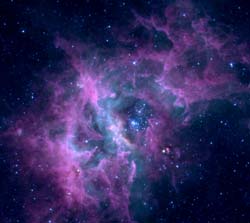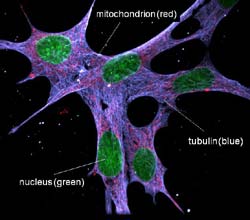This area deals with the fundamental laws and building blocks of nature and how they interact, the properties and the behavior of matter, and research into space and time and their structures.
innovations-report provides in-depth reports and articles on subjects such as astrophysics, laser technologies, nuclear, quantum, particle and solid-state physics, nanotechnologies, planetary research and findings (Mars, Venus) and developments related to the Hubble Telescope.

Using a new computer model of the Sun, scientists have begun work on a groundbreaking forecast of the next cycle of sunspots. Mausumi Dikpati of the National Center for Atmospheric Research (NCAR) announced new research leading to an improved forecast of cycle 24 at the annual meeting of the American Astronomical Society (AAS) in Denver. Predicting features of the solar cycle may help society anticipate sunspots and associated solar storms, which can disrupt communications and power systems and exp

Some of the first data from a new orbiting infrared telescope are revealing that the Milky Way – and by analogy galaxies in general – is making new stars at a much more prolific pace than astronomers imagined.
The findings from NASA’s Spitzer Space Telescope were announced today (May 27) at a NASA headquarters press briefing by Edward Churchwell, a University of Wisconsin-Madison astronomer and the leader of a team conducting the most detailed survey to date of our galaxy in infrared l

New percolation model may allow researchers to study biochemistry at the atomic level A new report in the May 24 Proceedings of the Royal Society of London. Series A: Mathematical and Physical Sciences announces a mathematical model that will help researchers understand “cell signaling” and learn how single atoms travel along the circuitous pathways in a cell. The model is a new approach to look at percolation-the flow of a liquid or small particle through a porous material.

Astrophysical Virtual Observatory Proves To Be Essential Tool Active galaxies
Active galaxies are breathtaking objects. Their compact nuclei (AGN = Active Galaxy Nuclei) are so luminous that they can outshine the entire galaxy; “quasars” constitute extreme cases of this phenomenon, their powerful engine making them visible over a very large fraction of the observable Universe.
It is now widely accepted that the ultimate power station of these activities originates in sup

Quasars are the most brilliant of cosmic fireworks, shining out across billions of light-years of space. However, a recent study done at Gemini Observatory shows that they appear to blaze forth from humdrum galaxies in the early universe, and surprisingly, not from the giant or disrupted ones astronomers expected.
According to an international team of astronomers that studied an assortment of these luminous objects near the edge of the observable universe, these pedestrian galactic surroun

As the Cassini spacecraft hurtles toward a rendezvous with Saturn on June 30 (July 1, Universal Time), both Cassini and the Earth-orbiting Hubble Space Telescope snapped spectacular pictures of the planet and its magnificent rings.
Cassini is approaching Saturn at an oblique angle to the sun and from below the ecliptic plane. Cassini has a very different view of Saturn than Hubble’s Earth-centered view. For the first time, astronomers can compare equally sharp views of Saturn from two very